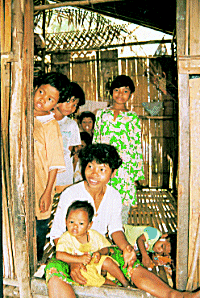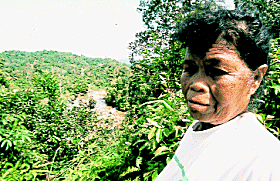|
Tuesday, February 2, 1999
Story by Pang Hin Yue with pictures by Hamsiah Abu Bakar and Pang Hin Yue
IT seems too much pain to bear for a toddler. One-and-a-half-year-old Anwar A'gan suffers from, among others, severe bronchitis and worm infestation. Lying on the bamboo floor with a high fever, he sucks on an empty feeding bottle in between coughs that send his tiny body retching.
His fever has persisted for four days but there is very little else his mother, Seri Inor, 30, and his seven older siblings can do except to comfort him.
They have no money. No medication. No food. No land. No job. No education. No piped water. No electricity. No support.
Seri's husband, who supported the family on earnings from the sale of petai and banana leaves, passed away last year leaving her to fend for their eight young children.
For Seri, a better life has been elusive since her family was forced out of their riverside village 15 years ago to make way for the Batu Dam near Batu Caves.
Orang Asli settlements like Seri's that fringe the rapidly urbanising Klang Valley have become further marginalised.
Ten-year old Sabrina, Seri's eldest daughter, for instance, has never been to school. Her younger siblings are likely to face the same destiny if the situation does not improve.
The community's repeated appeals to the Department of Orang Asli Affairs (Jabatan Orang Asli) to provide transport to schools have so far gone unheeded.
According to Mok Yusop, another victim of the Batu dam, the department's excuse is there are just too few children of school-going age to justify transportation.
But education is a basic right of all Malaysians. Is there any wonder why critics associate JOA - the Malay acronym for the Department of Orang Asli - with "Jual Orang Asli"?
Although the department was supposed to disband by 1990, it does not seem likely to happen anytime soon. "JOA is a powerful tool to control the Orang Asli," says one of its detractors, "and to take away their land."
As though it is not enough to deprive the children of Batu Dam of an education, the department has turned a deaf ear to the community's request for proper housing.
 NO MONEY, NO LAND ... Seri and her eight children have yet to see the light at the end of the tunnel after their displacement for the Batu Dam.
NO MONEY, NO LAND ... Seri and her eight children have yet to see the light at the end of the tunnel after their displacement for the Batu Dam.
Adds an equally frustrated Moh Madili, his neighbour: "Now they (JOA) tell us there is no allocation because of the economic recession. They know where we stay but they refuse to help."
"Kita tidak dibagi apa-apa...tak ada duit..tak ada pampasan...(We were not given anything)," Seri say, recalling her family's relocation for the Batu Dam and the related recreational development thereafter.
Although Mok's family received compensation, it was just RM3,000, a paltry sum that did not reflect the cost of the land and dusun (fruit orchard) the Selangor Government took from them.
Even so, "we were told that we were overcompensated," says Mok bitterly.
Today, the youthful Mok is reduced to doing odd jobs and living with his family of five in a home that his urban counterparts would consider ramshackle.
The irony of having to work for the resort operator of Laman Bistari, whose chalets now occupy the very spot his village once stood, is not lost on him.
One wonders why Laman Bistari is allowed to be situated along the river near the dam, when the Orang Asli community there was uprooted by the Selangor Government because it was deemed "unsafe".
Will the same fate befall the approximately 600 Orang Asli in Pertak and Gerachi near Kuala Kubu Baru, now that the State Government has renewed its intention to dam the upper reaches of Selangor River? (See story on Page Five of todays Life and Times in the New Straits Times).
If the project were to proceed, it would be the fifth dam built at the expense of Orang Asli, notes Colin Nicholas of Centre for Orang Asli Concerns.
As early as 1965, both villages were identified as Orang Asli areas but to date, they have not been gazetted as Orang Asli reserve.
Given the long history of Orang Asli being short-changed in the name of development, it comes as no surprise that the villagers of Pertak -- where houses will be submerged for part of the reservoir -- and Gerachi, the proposed dam site, are vehemently objecting against the proposed dam.
"We don't want the dam. We want to stay put in our village. We are prepared to face the consequences," declares Ramsit Anong, the batin (headman) of Gerachi who also works as a tour guide for the whitewater rafting operators at Selangor River.
Similar protests can be heard in Pertak.
"My ancestors have been living on this land for hundreds of years. Why should we leave? What about our dusun?" Minah Anggung of Pertak cries, as she points to two majestic bongkok durian trees that her great grandmother had planted (and named) about a century ago.
Rashid Aus, Minah's brother-in-law, is also resisting resettlement because he is afraid he will get a raw deal. "We did not receive any help in the past to obtain seedlings for planting our fruit and rubber trees. We don't expect any in the future, either."
Perhaps their biggest complaint is that they were not consulted on the impending dam.
It underscores yet again the State governments' lack of transparency and a complete disregard for Orang Asli's rights when dealing with land issues.
When they learnt about the project earlier last month, the leaders of Pertak and Gerachi villages attempted to arrange a meeting with the State development authorities in Shah Alam on Jan 15. But they were prevented from doing so by the JOA on the basis that they had to "wait" for an official letter.
To this, KBB State Assemblyman Ch'ng Toh Eng, who is also the State Exco on environment, responds: "I saw them a few weeks ago in KKB but they did not raise the matter with me. But they are most welcome to see me. I am willing to hear their side of the story."
Still, Ch'ng is of the opinion that the dam should proceed to avoid a repeat of the water crisis that beset Selangor last year. But critics argue, is building a new dam the solution? Has the State Government explored other options?
Notwithstanding the environmental impact of damming a river, the absence of Orang Asli/indigenous people land rights remains an unresolved fundamental issue.
Typically, the authorities' justification for resettling Orang Asli is that it will help them to "integrate" and "assimilate" into mainstream society. But Nicholas who has been active in the Orang Asli struggle for the past decade does not think so.
It is the weakest yet most often used argument because "the ulterior motive is to take away the Orang Asli land", he asserts.
Legislation such as the Aboriginal Peoples Act and the National Land Code fail to protect Orang Asli interest. Consequently, the Orang Asli have been relegated to "tenants at will", always at the mercy of State governments. This is despite the fact they may be living on what has been their ancestral land for centuries.
One cannot help but question the double standards practised here and in the case of landless peasants who became landed farmers under the Felda schemes, says Nicholas.
They receive huge compensation when their land is taken for development but the same cannot be said for the Orang Asli and other indigenous people in Sabah and Sarawak, he observes.
"While the Orang Asli have rights to use the land," he explains, "they do not have rights to the land."
The extent of land gazetted as Orang Asli reserves speaks for itself.
Based on his doctoral thesis, Nicholas has found that the total land area gazetted as Orang Asli reserves shrank by 10 per cent to 18,587ha in 1996 from 20,667ha in 1990.
He notes that at the same time, of the 36,076 ha originally approved for gazetting in 1990, approval for 6,198ha has been withdrawn.
In short, as more land is taken up for development, the less there is for the Orang Asli.
Has "development" in any way increased the economic pie of the Orang Asli? The only way to gauge, says Nicholas, is to do a comparison before and after a resettlement. In most instances, the Orang Asli have been on the losing end.
He reasons that if the Government sincerely wants the Orang Asli to be on equal footing with fellow Malaysians, there is plenty of scope for resolving the matter peacefully.
"It's a myth," he insists, "that Orang Asli are anti-development."
It is a matter whether the authorities have the moral courage to give Orang Asli land titles that are rightfully theirs and engage them actively in the development process - and at the same, respect their cultural beliefs and heritage.
If the Selangor dam prevails despite opposition, we can only hope that the people of Pertak and Gerachi would not fall onto same path as their their Batu Dam counterparts did.

DAMMING OF SELANGOR RIVER ... Minah is resisting relocation. The Selangor River is in the background.
|

